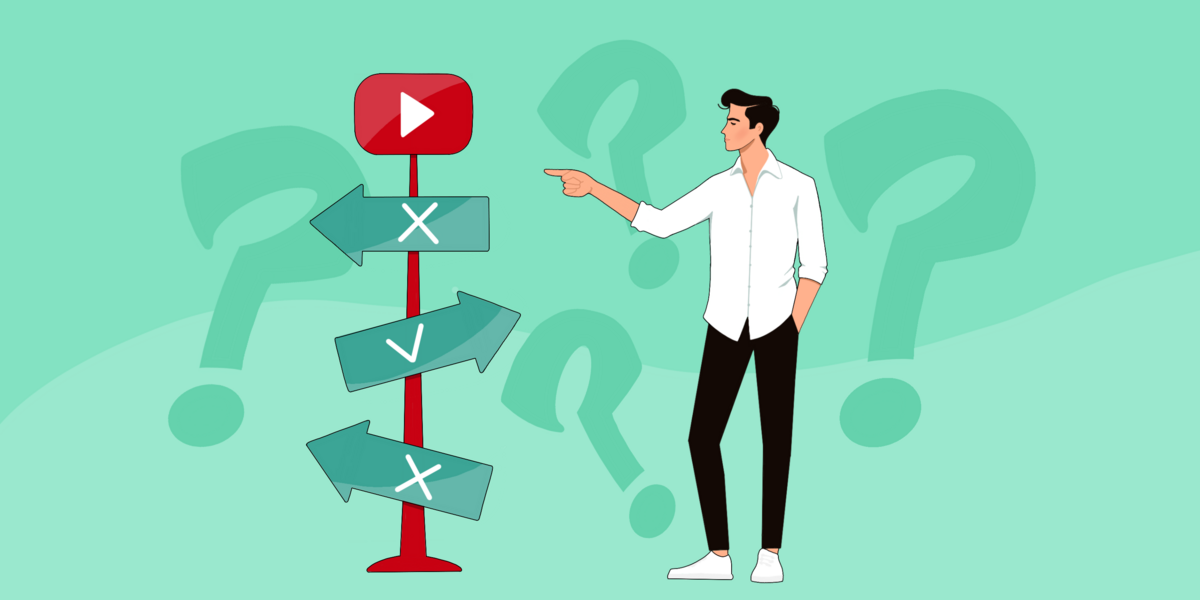7 Outdated Ideas You Should Beware of on YouTube

On YouTube, there are many traditions that make less and less sense for vloggers with each passing year. The world is not standing still, and YouTube is, of course, evolving along with it. So let's talk about which of the following "traditions" have long become outdated.
1. “Doing what you supposedly “should” do”
Perhaps this will sound quite strange, but the only "must do" concerning YouTube is to adhere to the platform's rules and regulations. That is what has real consequences, and everything else you can do at your discretion.
Apply this rule to everything you hear or read on the internet. Among thousands of experts, each will promote their personal experience, which may not be relevant to you at all. So, if you feel like you're doing something just because you think you should, but you dislike it—don't do it. It's as simple as that!
There are no more teachers above you, no strict supervisors, especially on YouTube: you are free to break the system as you please. If you want to evaluate results, focus primarily on your audience's reaction, not on imaginary "how it should be done" and "what should be done." There's nothing that can tell you if you're heading in the right direction better than views from your audience, their comments, reactions, and emotions.
When you are constantly in the context of your channel's theme, concentrated on content, and digging deep into the search for causes and effects, it's easy to lose sight of the bigger picture. Take a step back and look at your activity: what really helps you and what doesn't? What is valuable to you and what is not?
All that should genuinely concern you is your audience.
2. “Random content reigns on YouTube”
Random content exists and works, but creators’ perception of it is quite distorted. We all hear about well-known creators who skyrocketed thanks to this very "random," structure but we tend to overlook the following factors:
- How many unsuccessful attempts they made before a random video worked for them.
- How many other believers in luck similar to them failed.
We often forget about the number of people creating on YouTube in general, how many creators upload content daily hoping to have lightning strike and success usher in.
How many people genuinely work on content and achieve their deserved results, and how many get lucky due to a random stroke of luck.
Considering that lucky cases of success on YouTube are rare, the percentage of hitting the top this way tends towards zero. Rapid popularity doesn't guarantee that you can handle it or that it will last.
In reality, skyrocketing into trends is much easier than maintaining a role of an interesting and popular creator. Therefore, it's crucial to come to YouTube with a plan or at least a minimal strategy, as well as an understanding of what you want to do with your channel, what you expect, and what you plan to do when you get those coveted views.
3. "You need Shorts because it's a popular format"
Let's unpack this step by step: Shorts are just as much a type of content as long videos. And if we've just established that a channel always needs some plan, development strategy, or at least a goal, then why don't Shorts deserve the same treatment? YouTube itself has placed short videos on par with long ones by introducing the opportunity for creators to join the Partner Program and earn from monetization by creating Shorts.
Both short and long videos have their own recommendation systems, algorithms that creators can work with to gain views and subscribers. Mixing these two formats thoughtlessly is like trying to create, for example, videos and songs and expecting the same result and audience reaction. But these are different content formats.
Your channel's theme might not require short videos at all, and they might hinder the promotion of your long videos. If you are a beginner, it's worth determining early on what content format you want to create on your channel: short or long. Because establishing a correct strategy for using Shorts alongside long videos right away can be challenging.
However, creating Shorts alongside long videos can still be done without spoiling anything and may even help the channel to promote more effectively. This will require a thoughtful strategy, experience, and an understanding of what and why you will be doing.
In summary, if there is a rumor that creating Shorts is mandatory for promotion, the answer is unequivocal: no, it's not necessary. Don't fall for trends. You may not need short videos at all, despite what everyone around you, including YouTube, may be "selling" you.
4. “You won't gain subscribers and views for a long time”
This is by no means mandatory. On YouTube, you'll benefit from having a plan of action, but many novice vloggers are truly unaware of the power of strategy. Even more are not aware that running a vlog requires some form of strategy.
You can linger on YouTube for an endless amount of time with ten subscribers and a couple of views on each video if you don't understand where they should come from. But as soon as you at least rudimentarily contemplate the purpose of your presence on the platform, it will become much easier for you to create meaningful content, strive for objective goals, and promote more effectively on YouTube.
Below are some questions that will help you uncover your channel’s purpose on YouTube. Ask yourself the following:
1. Why did you create a channel on YouTube? Benefit, entertainment, finding like-minded people, videos for yourself/friends/family.
2. What do you want to offer to your audience? Benefit, knowledge, case studies, emotions, solving certain issues/pains, simply spending good time together.
3. What do you want to gain from YouTube? The opportunity to earn, popularity, business promotion, expanding the customer base, the opportunity for self-realization.
4. How do you want to present yourself on YouTube, and how don't you? What values do you convey? What do you want to be associated with?
These simple questions will help you see more clearly the path to your goal on YouTube and what tools will help you achieve them. Then, you won't have to linger in YouTube limbo for years, waiting for subscribers and views that may never come.
5. “It is necessary to make complex banners or thumbnails”
There is a significant difference between creating a captivating banner and a dull one. To make a banner or thumbnail captivating, you don't necessarily have to go all out in its creation. Most thumbnails that effectively fulfill their purpose are simply engaging images, memes, clickbait captions, and up-to-date trends.
If you have no understanding of appealing images, working with text, color, and at least minimal design, then it's worth studying at a basic level. However, delving into the theory of Aristotle's color is not necessary.
To improve the clickability of thumbnails, pay attention to two factors: context and direction.
If a person needs to watch the video to understand what your thumbnail is about, it's a bad thumbnail. It means the context of your video is not clear and appealing to the viewer.
If you place uncommon jokes on your video thumbnail, use highly specialized slang not intended for a broad audience, then it's a bad thumbnail.
Your thumbnail should initially be directed at a broad audience. You can outline all additional information in the description and title of the video. Leave only one task for the thumbnail: to effectively grab the audience's attention.
6. "Give your audience what they are asking for"
Listening to your audience and catering to their every whim are not the same thing at all. Taking into account the opinions of your viewers is essential; after all, vloggers create content specifically for them, and the audience is what drives the videos.
However, it's crucial not to overlook the fact that people express their own opinions in the comments, which are based on personal subjective feelings. This means their opinions do not necessarily reflect the majority. If you create a video based solely on comments, it will often be unpopular as it may cater to a limited audience.
People don’t often know what they really want, so the objective amplifier of their opinions will be the statistics of your channel, which you can find in YouTube Analytics.
Also, don't forget that you are the one shaping the atmosphere on your channel: if you establish a totalitarian regime with bans on any negative word towards you, don't expect a pleasant atmosphere on the channel or any substantial expressions about your content.
If you respond to every comment to show interest in interacting with the audience, be prepared that it will become more challenging as your audience grows, and they will expect this behavior from you. If you decide to stop responding to comments, you may immediately face consequences.
Through your videos, statements, community posts, and even responses to comments, you create a certain positive expectation among your audience. It's essential to answer this question beforehand: what kind of behavior do you want to evoke from your viewers. Use your answer to the aforementioned question to guide your strategy.
7. “There is a certain set of steps, that are necessary for success”
Let’s be honest with ourselves, this belief is both outdated and holds no truth. Consider the following..
On YouTube, there are no hard rules of what you "must" or "should" do, for creating successful content. As we've already established, unless the question relates to YouTube Policies. However, there is a certain set of actions regarding content and channels that have proven to be effective.
It's not a rule or obligation; it's just the collective experience of thousands of creators who have tested various methodologies, and for most, these tactics worked positively. For example, videos are more engaging when they are well-presented, with an engaging thumbnail and title. Another example is that well-shot videos with an interesting plot often become popular.
If you decide to try a certain tactic in managing your channel or creating content, there is a specific set of actions that comes with it. For instance, if you want to create videos with compelling plots, you might want to explore storytelling, learn to use the three-act structure, add conflicts and twists throughout the video, and write well-crafted and interesting scripts.
However, this is by no means something mandatory that you cannot achieve success on YouTube without. Even if you want to make interesting videos, you can choose not to learn any of this. It's like a list of additional literature: you decide whether to read it for your development or not.
It's entirely possible that you can observe how creators in your niche do things, do the opposite, and go viral precisely because of this bold move.
Experiments are an integral part of working on YouTube, even if you decide to follow all the templates tested by others. Sooner or later, your channel may hit a ceiling, and you'll have to try something new. And that's okay.
Remember: everything you do on YouTube should bring you joy. Any action you take regarding your content reflects your attitude. If your videos come across as insincere, viewers will sense this and stop watching. Never forget about your motivations for creating content and always maintain a passion for your channel. The rest you can tweak and figure out as you grow. Good luck!




